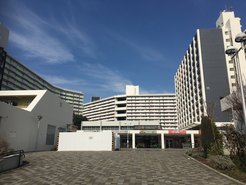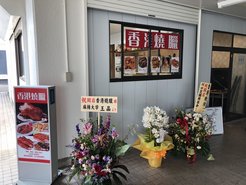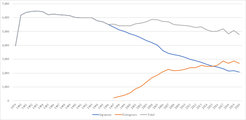
Shibazono Danchi: a Japanese public housing complex as part of the migration infrastructure for Chinese IT workers
Tetsuya Imaoka
Imaoka, Tetsuya. 2021. Shibazono Danchi: a Japanese public housing complex as part of the migration infrastructure for Chinese IT workers. MoLab Inventory of Mobilities and Socioeconomic Changes. Department ‘Anthropology of Economic Experimentation’. Halle/Saale: Max Planck Institute for Social Anthropology. https://doi.org/10.48509/molab.3003
Download as PDF
Introduction

Shibazono Danchi (Figure 1.), a public housing complex in Greater Tokyo, has been famous nationwide because of the concentration of Chinese immigrants. Built in 1978 with nearly 2,500 units, Shibazono has easy access to the centre of Tokyo. It was one of many ordinary Danchi, Japan’s public housing complexes. However, as Japanese residents grew older and decreased in number, Chinese immigrants started flowing into Shibazono Danchi in the 1990s, outnumbering Japanese residents since 2016. Many of these Chinese immigrants are IT professionals working in Greater Tokyo. As the number of Chinese residents increased, Chinese-run businesses opened in the shopping street of Shibazono Danchi, which has made some feel like it has turned into an ethnic neighborhood (Figure 2.)

Below, I study two points by adopting an infrastructural perspective. First, I examine how public housing can facilitate immigrants’ mobility rather than being a mere endpoint of migration. As part of the migration infrastructure, Shibazono Danchi promotes the mobility of Chinese IT workers in cooperation with an emerging chain of intermediaries. Deeply rooted in Japan’s labor shortage in the IT sector, the development of the offshore IT industry in Dalian, Northeast China, has led to Chinese IT workers’ immigration to Japan. Supporting their mobility, the emerging chain of intermediaries required a cheap and convenient housing option for Chinese IT workers’ arrival housing; that is, Danchi. The incessant inflows of Chinese IT workers have benefited the public housing institute, which has suffered from financial loss.
Second, I analyze the relationship between the “infrastructurization” of Shibazono Danchi and Chinese IT workers’ mobile livelihoods in Shibazono. Despite the increasing number of Chinese residents, they have hardly formed a strong migrant network. One reason is that the character of Shibazono Danchi as their temporary housing makes it difficult for them to establish sustaining relationships. The other is that, as dispatched IT workers rotating from one project to another, Chinese residents in Shibazono have a highly mobile lifestyle in which they can hardly connect with their employer, clients, and colleagues.
Migrant Concentration in Shibazono Danchi
Over more than three decades, Japan’s public housing complexes, or Danchi, experienced migrant concentration. Many of them were constructed during the post-World War II economic boom following a severe housing shortage in urban regions. In 1955, the Japan Housing Corporation was established under the supervision of the Ministry of Construction. The Corporation provided housing primarily to urban middle-class citizens until they were dissolved into another governmental institution in 1981. However, many Danchi in suburban areas, including Shibazono, have experienced rapid population aging. As of 2020, 36.9 percent of Danchi residents were older than 65[1], while the national rate is 28.7 percent.[2] The reason is that they accommodate residents from a particular generation due to the housing shortage.[3] Since the year in which a Danchi was built determines the primary age of the inhabitants, all the residents there would experience aging at the same time. Moreover, the aging of the buildings has made Danchi less attractive to younger generations. As a result, even deaths of old Japanese residents in Danchi have increased since the late 1990s, attracting media attention.[4]
It is immigrants who have relocated into many of the vacant rooms in these Danchi. As of 2015, at least 110 Danchi have experienced migrant concentration, defined as more than 15 percent of immigrants of the entire population[5]. The nationalities of immigrants in the Danchi vary. Out of 50 Danchi, where 80 to 90 percent of the migrant population is considered to have the same nationality, 28 experienced a concentration of Brazilians, seven of Chinese, and six of Koreans.[6]
Shibazono Danchi is one such, if not typical, example. While Japanese resident numbers have decreased due to their aging, the numbers of younger Chinese residents have rapidly increased since the 1990s (see Figure 3 for changes in the population structure).[7] As far as I have observed, while many Chinese residents are younger than 40, most Japanese residents are older than 50. The Chinese residents are characterized by a high turnover rate.

There is a consensus among Japanese residents that many Chinese residents came from Northeast China, work in the IT industry, and live in Shibazono only for a short period. In a survey conducted in 2019 by the managing institution of Shibazono Danchi, the Urban Renaissance Agency (the UR), approximately 40 percent of 65 foreign residents lived in Shibazono for two to three years, and no respondent lived there for more than ten years.[8] Although the sample size is too small to generalize the result, the length of stay matches Japanese residents’ agreed opinion.
Background: the Development of the Offshore IT Industry in Dalian, Northeast China
Shibazono Danchi has become part of the migration infrastructure that facilitates Chinese IT workers’ mobility. Migration infrastructure refers to the intermediary processes that facilitate migration[9]. The emergence of the migration infrastructure for Chinese IT professionals can be traced to the development of the offshore IT industry in Dalian, Northeast China. The offshore IT industry in Dalian has developed under the guidance of the city government seeking to transform its primary industry.[10]
Japan has become one of Dalien’s primary customers for three reasons. First, labour outsourcing has become common in Japan’s IT industry since the 1990s. In the Japanese IT industry, many companies have outsourced labour on an ad-hoc basis since the 1990s to lower cost.[11] Second, the industry has faced a severe labour shortage. With the rapidly aging population, Japan faced a labor shortage of 220,000 IT workers in 2018, and this number may rise to 787,000 by 2030[12]. As a result, the demand among Japanese IT companies for offshore IT enterprises has increased. In 2007, 40.6% of 514 IT companies were either already outsourcing their labour to offshore companies or planning to do so. Third, there is an ample supply of Japanese-speaking IT workers in Dalien. This is because Japanese language education in Dalien has continued since the age of Japan’s colonial rule between 1905 and 1945. There is an estimate that Japanese-speaking Chinese IT professionals account for 30,000 to 40,000 of the 100,000 people working in Dalian’s IT industrial parks.[13]
This flow of immigration is also a product of the Japanese government’s IT policies. In 2000, facing the increasing importance of digital technologies, the government formulated its first plan to develop the Japanese IT industry, entitled the “e-Japan strategy,”.[14] The “strategy” called for the immigration of approximately 30,000 IT professionals by 2005. Moving forward this policy, Japan has mutually recognized the qualifications of IT professionals with 12 other Asian countries so far.[15]
Rising Intermediaries in Migratory Processes
Intermediaries are deeply involved with Chinese IT workers’ migratory processes. As the first step in migratory processes, recruitment intermediaries in Dalien support Japanese IT companies. For instance, in 2018 and 2019, a Japanese recruitment intermediary held job fairs in Dalien for IT companies in Japan to recruit Japanese-speaking Chinese university students. Once a contract was formed, the company offered all logistic support to IT companies that hire Chinese students.[16]
Danchi, including Shibazono, have become part of the infrastructure managed by intermediaries. Intermediaries rent Danchi as the initial housing of Chinese employees arriving in Japan. A Chinese-run IT company in Japan told me that they asked a Chinese-run real estate agency to suggest the most reasonable housing option, which is always a Danchi. An employee of the company said that Danchi were cheaper than private housing because they did not require a security deposit and contract renewal fees. In other words, the initial cost of renting Danchi is lower, and one can cancel the contract at any time without incurring any financial penalties. The company rented five units in different Danchi in Greater Tokyo at the time of my interview. The interviewee suggested that the use of Danchi as migrant workers’ accommodation has become a common practice in the IT industry.
Moreover, the public housing institution tacitly welcomes migrant concentration in Shibazono because it is profitable. Since the UR has faced financial difficulty, they have sought to maximize profits from their properties. As of 2013, the agency’s interest-bearing debts were worth 12.7 trillion Japanese Yen.[17] As a result, in 2013, the government established a reform plan: “The provision of the housing safety net is very important, but in general, the key is to privatize [the UR] as much as possible and make the system profitable”.[18] This wave of privatization reached Shibazono Danchi. A UR staff told me that Shibazono was an “excellent property”, which generates profits because new Chinese residents and tenants continuously flow in.
Yet Shibazono Danchi is merely a temporary housing for Chinese IT workers for three reasons. The first reason is that they often share the same apartment with one to three colleagues. Thus the space is very crowded, making Shibazono Danchi a less attractive housing option. Moreover, although some rooms are renovated, the building is more than four decades old, which causes frequent neighborhood disputes about noises. Finally, should they invite other family members to Japan or get married, they need to move out of their dormitory. One of the managing staff of Shibazono Danchi told me that Chinese residents often relocate to larger rooms within the Danchi for the reasons above. This gives Japanese residents the impression that they constantly move into and out of the Danchi.
Migrant Concentration without a Strong Network
Because Shibazono Danchi is used by intermediaries and companies to facilitate the Chinese migrants’ arrival, the concentration does not lead to strong connections among the migrants. The Chinese residents whom I interviewed told me that they barely knew other Chinese residents in Shibazono. Furthermore, when there is a constant turnover of the migrant population, it is hard to establish lasting relationships among them. Another reason for the lack of strong connection is Chinese IT workers’ workstyle which is extremely mobile on a daily basis. Many Chinese IT workers in Shibazono Danchi are dispatched to the client’s office until a project is complete. This way of working derives from multiple subcontracting in the IT industry, which has become a common practice. A governmental survey in 2019 shows that 87% of the 3660 companies in the information industry undertake projects as prime contractors, 56.7% as first-tier subcontractors, 25.2% as second-tier subcontractors, and 7.8% as third-tier or higher subcontractors.[19] In other words, when a company places an order for a project with an IT company, the IT company asks a subcontractor to execute the project, the process which can be repeated multiple times. This means that when a client orders a project, their office will receive engineers from several different companies. Put differently, IT workers need to change their workplace and colleagues every time a project is complete. Moreover, since projects do not usually last for decades, they have to repeat this process in a short period, which makes it difficult for them to establish lasting relationships. Furthermore, as they are dispatched workers, they do not have much chance to get to know other IT workers who belong to the same dispatching company. As such, IT workers, including Chinese residents in Shibazono, can have weak connections with their colleagues, clients, and employers.
In this essay, I captured how Shibazono Danchi has promoted Chinese IT workers’ mobility as part of the migration infrastructure, and how this “infrastructurization” has influenced the migrants’ mobile lifestyles. The relationship between public housing and migration infrastructure is a novel topic, which should be explored more in further research.
[1] The Urban Renaissance Agency. 2021. Reiwa 2 nenn UR Chintai Jutaku Kyojusha Teiki Chousa Kekka ni tsuite[Results of the 2020 Periodic Survey of Residents of UR Rental Housing] Available online at: https://www.ur-net.go.jp/aboutus/press/lrmhph000001whu6-att/ur2021_press_0730_r2teikicyosa pdf. Last accessed 22 September 2022.
[2]Statistic Bureau of Japan, n.d. 1. Koureisha no Jinkou [1. Elderly Population] Available online at: https://www.stat.go.jp/data/topics/topi1261.html. Last accessed 22 September 2021.
[3] Yamashita, Yusuke. 2012. Genkai Shuraku no Shinjitsu: Kaso no Mura ha Kieruka? [The truth about communities at crises: will depopulated villages disappear?] Chikuma Shobo, Tokyo.
[4] Koike, Takashi. 2017. “Danchi zoku” no ima [The Presence of the “Danchi tribe”] Shoshi Kurarute, Kyoto.
[5] Wang, Shuang and Sayaka Fujii. 2020, A Study on the Conditions and Efforts of the Public Housing Densely Inhabited by Foreigners: Analysis of Questionnaire Survey of Public Housing Managers across Japan, Journal of the City Planning Institute of Japan, Vol.55, No.3, pp. 954-961.
[6] Ibid.
[7] Kawaguchi City Government. various years. Cho Cho Aza Ji Nenrei Betsu Jinkou [Population by age by town and street] Available online at: https://www.city.kawaguchi.lg.jp/soshiki/01020/010/toukei/12/2734.html. Last accessed 22 September 2021. There is no large housing except the housing complex and an apartment with 217 households in this district. Since the data on the number of foreigners is only available from 1997 to 2020, the total population is equivalent to the Japanese population from 1979 to 1996.
[8] Oshima, Takashi. 2019. Shibazono Danchi ni sundeimasu [I live in Shibazono Danchi] Akashi Shoten, Tokyo [Electronic Resource] p.1392; 2201. The UR has not disclosed the survey in question.
[9] Xiang, Biao and Johan Lindquist. 2014. Migration Infrastructure, The International Migration Review, vol. 48, no. 1, pp. S122-147.
[10] Zhang, Yan and Nozomi Kawabata. 2012. The Formation of the Software and Information Services Industry in Dalian, China, Journal of Asian Management Studies, vol. 18, no. 0, pp. 35-46.
[11] Information Processing Promotion Section, Ministry of Economy, Trade and Industry. 2015. IT Jinzai wo meguru Genjou ni tsuite[The current situation regarding IT personnel] p. 11. Available online at: https://www.meti.go.jp/shingikai/sankoshin/shomu_ryutsu/joho_keizai/it_jinzai/pdf/001_04_01.pdf. Last accessed 22 September 2021; Kazuya Kinoshita. 2014. Reorganization of the System Integrator in Japan: Strategy and Structure of information Service Industry. Japan Academy of East-Asia Enterprise and Business Administration. Vol.2, pp. 11-23.
[12] Mizuho Information & Research Institute, Ltd. 2019. IT Jinzai Jukyu ni taisuru Chousa Chousa Houkokusho[Report: Survey on Supply and Demand of IT Human Resources] p. 18. Available online at: https://www.meti.go.jp/policy/it_policy/jinzai/houkokusyo.pdf. Last accessed 22 September 2021. This survey was commissioned by the Ministry of Economy, Trade and Industry.
[13] Kenjirou, Sekine. 2021. Chugoku Oote Jinzai Gaisha ni Manabu! Nihongo ga Hanaseru Yushu na Nihongo Enjinia wo Saiyou suru houhou [Learn from China's leading recruitment agency! How to recruit Chinese IT engineers who speak Japanese] Global HR Magazine. Available online at: https://global-hr.lift-group.co.jp/69. Last accessed 22 September 2021.
[14] IT Strategic Headquarters. 2000. e-Japan senryaku [e-Japan Strategy] Available online at: https://www.kantei.go.jp/jp/it/network/dai1/1siryou05_2.html. Last accessed 22 September 2021.
[15] IPA. Johou Gijutsusha no Kaigai tono Sougoninshou nit suite [Regarding the Mutual Recognition of IT Qualifications with Foreign Countries] Available online at: https://www.ipa.go.jp/jinzai/asia/kaigai/001.html. Last accessed 26 October 2021.
[16] Dairen Joui Daigaku no Gakusei wo Atsumeta Kisetsu Gentei “Saiyou Mensetsukai” “Barujobu Dairen” wo Kaisai. 2018.[Will be held ”Valujob Dalian”, a seasonal "job fair" for students from Dalian's top universities] NeoCareer Group. Available online at: https://www.neo-career.co.jp/news/article_11916/. Last accessed 22 September 2021.
[17] The Urban Renaissance Agency. 2013. UR no Zaimu Jyoukyou ni Tsuite [On the Financial Status of the UR] p.2. Available online at: https://www.kantei.go.jp/jp/singi/gskaigi/kaikaku/wg4/dai2/siryou5.pdf. Last accessed 4 October 2021.
[18] The Administration Reform Promotion Council. 2013. UR no Kaikaku ni kansuru koremade no Iken ni tsuite [On Existing Opinions on the Reform of the UR] p.1. Available online at: https://www.kantei.go.jp/jp/singi/gskaigi/kaikaku/wg4/dai2/siryou1.pdf. Last accessed 4 October 2021.
[19] Information and Communications Statistics Database, Ministry of Internal Affairs and Communications. 2021. Jouhou Tsuushingyou Kihon Chousa [Results of a basic survey of the information and communications industry] p. 52. Available online at: https://www.soumu.go.jp/johotsusintokei/statistics/data/jouhoutsuusin210528b.pdf. Last accessed 22 September 2021.
This is an Open Access article, distributed under the terms of the Creative Commons Attribution licence (https://creativecommons.org/licenses/by/4.0/), which permits unrestricted re-use, distribution, and reproduction in any medium, provided the original work is properly cited.


